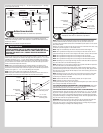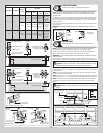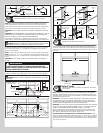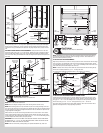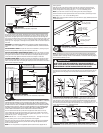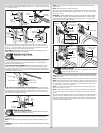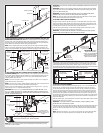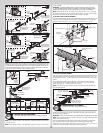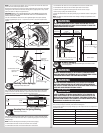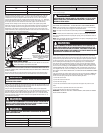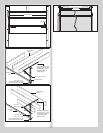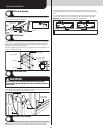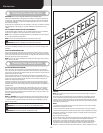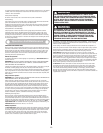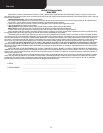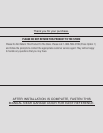
7’3” 7-7/8
7’6” 8
7’9” 8-1/4
8’0” 8-3/4
Alternately inserting the winding rods into the holes of the spring winding cone, rotate the
winding cone upward toward the ceiling, 1/4 turn at a time, until the required number of
complete turns for your door height is achieved. As the last 1/8 to 1/4 turn is achieved,
securely hold the winding rod and carefully stretch the torsion spring 1/8” - 1/4”. Next while
still securely holding the winding rod, tighten both set screws in the winding cone to 14-15 ft.
lbs. of torque (once set screws contact the torsion shaft, tighten screws one full turn).
Carefully remove winding rod from winding cone. Repeat for the opposite spring. While
holding the door down to prevent it from raising unexpectedly in the event the spring(s) were
over-wound, carefully remove the locking pliers from the torsion shaft and vertical tracks.
Adjustments to the number of turns stated may be necessary. If door rises off floor under
spring tension alone, reduce spring tension until door rests on the floor. If the door is hard to
rise or drifts down on its own, add spring tension.
HIGH SPRING TENSION CAN CAUSE
SERIOUS INJURY OR DEATH.
DO NOT adjust, repair or remove springs or parts to
which springs are connected, such as steel brack-
ets, cables, wood blocks, fasteners or other parts of
the counterbalance system.
Adjustments or repairs must ONLY be made by a
trained door systems technician using proper tools
and instructions.
DO NOT remove, cover or paint over this tag. Prod-
uct user should inspect this tag periodically for
legibility and should order a replacement tag from
the door manufacturer, as needed.
©Copyright 2010 Overhead Door Corporation
102081 REV2 06/24/2010
HIGH SPRING TENSION CAN CAUSE
SERIOUS INJURY OR DEATH.
DO NOT adjust, repair or remove springs or parts to
which springs are connected, such as steel brack-
ets, cables, wood blocks, fasteners or other parts of
the counterbalance system.
Adjustments or repairs must ONLY be made by a
trained door systems technician using proper tools
and instructions.
DO NOT remove, cover or paint over this tag. Prod-
uct user should inspect this tag periodically for
legibility and should order a replacement tag from
the door manufacturer, as needed.
©Copyright 2010 Overhead Door Corporation
102081 REV2 06/24/2010
Torsion shaft
Winding
cone
Torsion
spring(s)
Approved
winding
rod
Set screws
IMPORTANT: CHECK THE WARNING
TAG(S) ATTACHED TO THE SPRING(S)
FOR THE REQUIRED NUMBER OF
COMPLETE TURNS, TO BALANCE
YOUR DOOR.
Warning
tag(s)
Approved winding rod
Torsion spring(s) should be wound in the direction the end coil points.
Spring
coils
Rear Back Hangs
Tools Required: Ratchet wrench, Socket: 1/2” 5/8”, Wrench: 1/2” 5/8”, (2) Vice
clamps, Tape measure, Level, Hammer, Step Ladder
27
IMPORTANT: HOLD THE DOOR DOWN TO PREVENT IT FROM RISING UNEXPECTEDLY IN THE
EVENT THE SPRING(S) WAS OVER-WOUND AND CAUTIOUSLY REMOVE VICE CLAMPS FROM
VERTICAL TRACKS.
Raise the door until the top section and half of the next section are in the horizontal track
radius. Do not raise door any further since rear of horizontal tracks are not yet supported.
WARNINGWARNING
RAISING DOOR FURTHER CAN RESULT IN DOOR FALLING AND CAUSE
SEVERE OR FATAL INJURY.
Clamp a pair of vice clamps onto the vertical tracks just above the second track roller on one
side, and just below the second track roller on the other side. This will prevent the door from
raising or lowering while installing the rear back hangs.
Using the chart (Perforated Angle Gauge Weight Limitations) below, use the appropriate
perforated angle (may not be supplied), (2) 5/16” x 1-5/8” hex head lag screws and (3) 5/16”
bolts with nuts (may not be supplied), fabricate rear back hangs for the horizontal tracks.
Attach the horizontal tracks to the rear back hangs with 5/16” - 18 x 1” hex bolts and nuts
(may not be supplied). Horizontal tracks must be level and parallel with door within 3/4” to
7/8” maximum of door edge.
WARNINGWARNING
EXCEEDING THE RECOMMENDED LISTED DOOR WEIGHT LIMITATIONS OF
SPECIFIC GAUGE PERFORATED ANGLES MAY RESULT IN DOOR FALLING
WHEN RAISED, CAUSING SEVERE OR FATAL INJURY.
WARNINGWARNING
VERIFY PERFORATED BACK HANG ANGLE LOAD RATINGS WITH BACK
HANG ANGLE SUPPLIER.
Perforated Angle Gauge Weight Limitations:
Perforated Angle Gauge Door Weight
2” x 2” x 12 Gauge Door Weight Less Than 800 lbs.
1-1/4” x 1-1/4” x 13 Gauge Door Weight Less Than 305 lbs.
1-1/4” x 1-1/4” x 15 Gauge Door Weight Less Than 220 lbs.
Perforated Angle Gauge Weight Limitations:
1-1/4” x 1-1/4” x 16 Gauge Door Weight Less Than 175 lbs.
NOTE: If an opener is installed, position horizontal tracks one hole above level when securing
it to the rear back hangs.
WARNINGWARNING
KEEP HORIZONTAL TRACKS PARALLEL AND WITHIN 3/4” TO 7/8” MAXI-
MUM OF DOOR EDGE, OTHERWISE DOOR COULD FALL, RESULTING IN
SEVERE OR FATAL INJURY.
IMPORTANT: DO NOT SUPPORT THE WEIGHT OF THE DOOR ON ANY PART OF THE REAR
BACK HANGS THAT CANTILEVERS 4” OR MORE BEYOND A SOUND FRAMING MEMBER.
NOTE: If rear back hangs are to be installed over drywall, use (2) 5/16” x 2” hex head lag
screws and make sure lag screws engage into solid structural lumber.
NOTE: 26” angle must be attached to sound framing members and nails should not be
used.
Now, permanently attach the weatherstrips on both door jambs and header. The weather-
strips were temporarily attached in Preparing the Opening, in the pre-installation section of
this manual.
NOTE: When permanently attaching the weatherstrips to the jambs, avoid pushing the weath-
erstrips too tightly against the face of door.
WARNINGWARNING
PRIOR TO WINDING OR MAKING ADJUSTMENTS TO THE SPRINGS, EN-
SURE YOU’RE WINDING IN THE PROPER DIRECTION AS STATED IN THE
INSTALLATION INSTRUCTIONS. OTHERWISE THE SPRING FITTINGS MAY
RELEASE FROM SPRING IF NOT WOUND IN THE PROPER DIRECTION AND
COULD RESULT IN SEVERE OR FATAL INJURY.
Now, lift door and check its balance. Adjustments to the required number of spring turns
stated may be necessary. If door rises off floor under spring tension alone, reduce spring
tension until door rests on the floor. If the door is hard to rise or drifts down on its own, add
spring tension. A poorly balanced door can cause garage door operator operation problems.
To adjust spring tension, fully close door. Apply vice grips to track above third track roller.
Insert a winding rod into the winding cone. On single spring doors, counterbalance lift
cable tension must be maintained by placing vice grips on torsion shaft before loosening
set screws in the winding cone. Push upward on the winding rod while carefully loosening
the set screws in the winding cone. BE PREPARED TO SUPPORT THE FULL FORCE OF THE
TORSION SPRING ONCE THE SET SCREWS ARE LOOSE. Carefully adjust spring tension 1/4
turn. Retighten both set screws in the winding cone and repeat for the other side. Recheck
door balance. DO NOT ADJUST MORE THAN 1/2 TURN FROM THE RECOMMENDED NUMBER
OF TURNS.
If the door still does not operate easily, lower the door into the closed position, UNWIND THE
SPRING(S) FULLY (Reference the insert “Removing The Old Door / Preparing The Opening”
section on torsion spring removal) and recheck the following the items:
1.) Check the door for level.
2.) Check the torsion shaft for level.
3.) Check the track spacing.
4.) Check the counterbalance cables for equal tension and proper wrap onto the cable
drums.
5.) Check the track for potential obstruction of the track rollers.
6.) Clamp locking pliers onto track and rewind springs.
IMPORTANT: IF DOOR STILL DOES NOT OPERATE PROPERLY, THEN CONTACT A TRAINED
DOOR SYSTEM TECHNICIAN.
16



